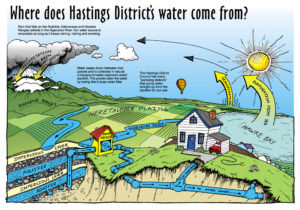An independent inquiry into the contamination of Havelock North’s water supply will begin its work this week, the Government has announced, as a woman sickened with Campylobacter was diagnosed with symptoms confirmed as Guillain-Barre syndrome.
 Attorney-General Chris Finlayson has also revealed the members of the inquiry, who have to report back with their findings by March next year.
Attorney-General Chris Finlayson has also revealed the members of the inquiry, who have to report back with their findings by March next year.
Last month, the Government announced an inquiry into the Havelock North campylobacter outbreak, which has affected thousands of residents and been linked to the deaths of two elderly people.
Finlayson said the inquiry would be chaired by retired Court of Appeal judge Lyn Stevens QC.
“The members of the inquiry panel have the extensive legal, public health, local government and water management expertise required to conduct an inquiry of this nature,” Finlayson said.
The inquiry would start this week, but had until March 31 next year to report back.
It would focus on how the Havelock North water supply became contaminated and how it was dealt with, how local and central government agencies responded to the public health outbreak, and how to reduce the risk of a similar outbreak happening in future.
The latest outbreak made 5200 people sick and hospitalised 22. Two elderly women who died were found to have contracted campylobacter, but both had other health issues.
An investigation is under way to find how the bug made its way into the water. Evidence to date indicates it came from sheep or cattle and may have originated from near the bores.
So how is Wellington’s water made safe: chlorinated, fluoridated, then delivered to your glass.
Rachel Thomas of The Dominion reports that Kaitoke and Wainuiomata are home to Wellington’s two river-based water sources.
Greater Wellington Regional Council chairman Chris Laidlaw says the catchments of both the river sources in Kaitoke and Wainuiomata are in protected forest parks where there is virtually no human activity.
“There’s no agriculture up there and very little intrusions with the water. It’s pure water we get from the hills.”
That said, all water sourced from rivers is at permanent risk of contamination from faecal or other organic matter.
That is why it is chlorinated, says Lower Hutt Deputy Mayor David Bassett, who is also chairman of Wellington Water’s governance committee.
“It’s better to err on the side of caution, and we are very risk averse when it comes to Wellington’s river water supply.”
Most of the residents in Lower Hutt, Upper Hutt, Porirua and Wellington get either chlorinated river water, or a mix of chlorinated river water and aquifer water.
The region’s confined aquifer can be found at Waiwhetu in Lower Hutt. It is the only source of unchlorinated, unfluoridated water in the region, and supplies drinking water to more than 70,000 Hutt City residents.
Water from the aquifer is free of bacteria and other contaminants, Bassett says.
That is because it is at least a year old and goes through a natural filtration process as it makes its way through the aquifer layers.
“It doesn’t need to be chlorinated, and so long as the network [of pipes] is secure, it is safe to drink at the tap – and we test the water throughout the network to make sure that it remains safe.”
Over the past year, there have been four positive E.coli tests at reservoirs in the unchlorinated network, Bassett says.
When that happens, Wellington Water notifies regional health authorities, shuts off the system, chlorinates the relevant reservoir, and re-tests the water until it is all-clear.











